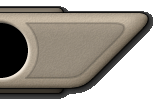Reviewer: Vincent Hendricks from Pearland, TX USA
Run for your Lives! Your DM can kill you in brand new ways!
Well, I've held off writing reviews of any of the 3e books because I really wanted a chance to get a bit more "familiar" (okay, mages and sorcerers can magic missile me for that pun) with the material and mechanics. All-in-all, I think the change has been good. Now for the specifics about the Monster Manual...
As the core books are intended to be, this volume is essential to a DM's arsenal for running a game. And, as with the rest of 3e thus far, the book is all about options. While much of 3e has been standardized (using a d20 for practically everything, making classes available to all races, etc.), this standardization has actually produced a greater possibility for customization. As players can do with their characters in the PHB, so can DMs do with the creatures in the MM.
For example, let's say the DM has decided that the long-term consumption of flora from a particular region in his campaign causes increased growth. How would you have accounted for this in game effects in 2nd Ed? You would have had to guess your way through it. Now, in 3e, whip out your MM, find the creature you want to put in that region, then turn to the front of the book, and use the size modifiers to adjust the creature's statistics. Simple. And consistent. Modify other creatures for that region the same way. No fox-eating rabbits because statistics are skewed....
Or, consider an orc tribe that has had the benefit of a high-level hermit mage living among them for an entended time, so now many of them have some arcane spellcasting ability. Again, very difficult to account for under 2nd Ed rules. In 3e, you just add a couple of levels of mage, and you're done. And the same can be applied to any other class for practically any creature...
The book is not without its problems. I found the division of the main body and the appendix unnatural. Why were animals, certain types of undead, etc. placed in the appendices rather than with the rest of the critters? The continuous format (one monster begins immediately where the previous ends, not on a new page) can make it difficult to quickly find the entry you want. While there are many illustrations, and most are very good, not all creatures have one. Finally, the introduction of the Challenge Level is a very interesting element, but I question its accuracy. There are many variables that can effect how challenging a party will find a creature to be, and it seems to me that there could have been more information on accounting for such variables when planning encounters for your party.
All-in-all, well done. Hey, no gaming product is perfect, even after three editions..... ;) People that are stuck on 2nd Ed (or even 1st Ed) aren't going to like it, but then again, they aren't going to like much of 3e, are they? It's hard to change from what you know; to many, the "quirks" of 1st and 2nd edition are what made the game Dungeons & Dragons. That's their choice. And for those of you that like the idea of 3e, that's your choice too.
Good Gaming!


